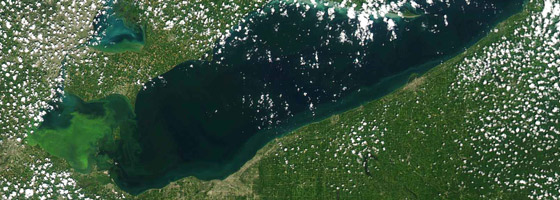From river to lake: Studying the source of Lake Erie’s algae woes

Ohio’s Maumee River, long known to ferry phosphorous-laden runoff into Lake Erie where it fuels huge blooms of harmful algae, is also delivering a dose of the algae itself, according to a recent study.
“It’s kind of like the river is supplying both the firewood and the spark,” said Tom Bridgeman, assistant professor of environmental sciences at the University of Toledo.
Bridgeman is the lead author of a study published recently in the Journal of Great Lakes Research that describes extensive sampling of western Lake Erie and the main stem of the Maumee before, during, and after a large bloom of the blue-green algae Microcystis. The blooms are a recurring problem that turn huge swaths of western Lake Erie green each summer and have the potential to produce dangerous toxins and oxygen-sucking dead zones.
The research tracked which types of phytoplankton and forms of phosphorous were most prevalent in the river and lake and how that changed over the bloom season. Though scientists have tracked phosphorous levels in the Maumee for years, there has been very little study on which phytoplankton species live in the river, said Doug Kane, assistant professor of biology at Defiance College. Kane is a co-author of the Maumee study and part of a similar project that tracked Microcystis in the main stem and tributaries of the Maumee and Sandusky rivers.
“What we found when we started these projects was that there wasn’t much data on phytoplankton algae for the rivers, so we really didn’t know it was there to begin with,” Kane said.
Rivers aren’t typically known to foster large algae populations, Bridgeman said. River water is always moving and often muddy, which doesn’t give algae the time or sunlight needed for growth. So even though they suspected they would find some Microcystis in the river, they were surprised by how much they found.
“We were surprised that we found Microcystis almost everywhere, almost all the time,” Kane said. “Very small tributaries to the main stem of the river, even in early spring.”
The researchers identified the Microcystis with a German instrument called a FluoroProbe, which can identify different groups of algae in a mixed sample based on their pigments. Bridgeman said the tool has limitations, but can be very useful if you keep those in mind.
“It allows you to get a much quicker measurement than if you had to do the traditional microscopy, when you’re looking at a sample under a microscope and just counting everything,” he said.
It isn’t yet clear what role the river’s Microcystis population plays in the huge summer blooms on Lake Erie, but it could complicate scientists’ old assumption that the bloom springs entirely from algae cells sitting in the lake awaiting nutrients from the rivers to fuel their wild growth. It’s possible, Bridgeman said, that the cells from the river give the bloom a head start, kicking off the bloom season a little earlier than if it relied on lake cells alone.
But there are also signs that the river Microcsysits may not be all that important. For example, not all strains of Microcystis can produce the toxins that can sicken people who drink or swim in tainted water. Preliminary genetic testing seems to indicate that the river strains are nontoxic, Bridgeman said.
“We still don’t really know how much to blame the Maumee River Microcystis for the blooms in the lake,” he said. “On one hand, yes, it’s contributing Microcystis. It might act as a seed population to the Microcystis in the lake. On the other hand, the Microcystis in the river seems to be a different genetic strain than mostly what goes out in the lake.”
Whatever the source of the Microcystis, the bigger problem is the phosphorous fueling its growth. The study also tracked different forms of phosphorous in the lake and river, which is important because some forms are more bioavailable, or readily usable to help algae grow, Bridgeman said.
The study found that the most prevalent form of the nutrient in June in the river and lake was dissolved organic phosphorous—phosphorous that has recently been part of living tissue that could come from manure or sewage treatment plants. Bridgeman said dissolved organic phosphorous isn’t generally considered to be very bioavailable, and in a standard scientific analysis is often lumped into the same category as particulate phosphorous, which describes the nutrient when its stuck to grains of sediment or already within algae cells.
But even though dissolved organic phosphorous isn’t immediately ready to fuel algae growth, it might only take a day or two to transform into a more bioavailable form, Bridgeman said. And the fact that they found so much of it could mean that this is a more important form of phosphorous that previously thought.
“The phosphorous coming down the river, there’s more that’s going to be available to plants either right now or very soon than probably we might have thought,” he said. “That’s a pool of phosphorous that we were kind of missing before.”
Though the study focused on the phosphorous and Microcystis in the lake and river, Bridgeman and Kane agree that the solution to Lake Erie’s harmful blooms must ultimately unfold on the land.
“Whether (the algae) is growing in the river and being transported to the lake or growing in out in the lake, the nutrient issue is what has to be addressed on the land,” Kane said. “Either of those two things, it’s going to be the same fix: prevent nutrients from running off the land into the water.”
Image credits: NOAA




0 comments